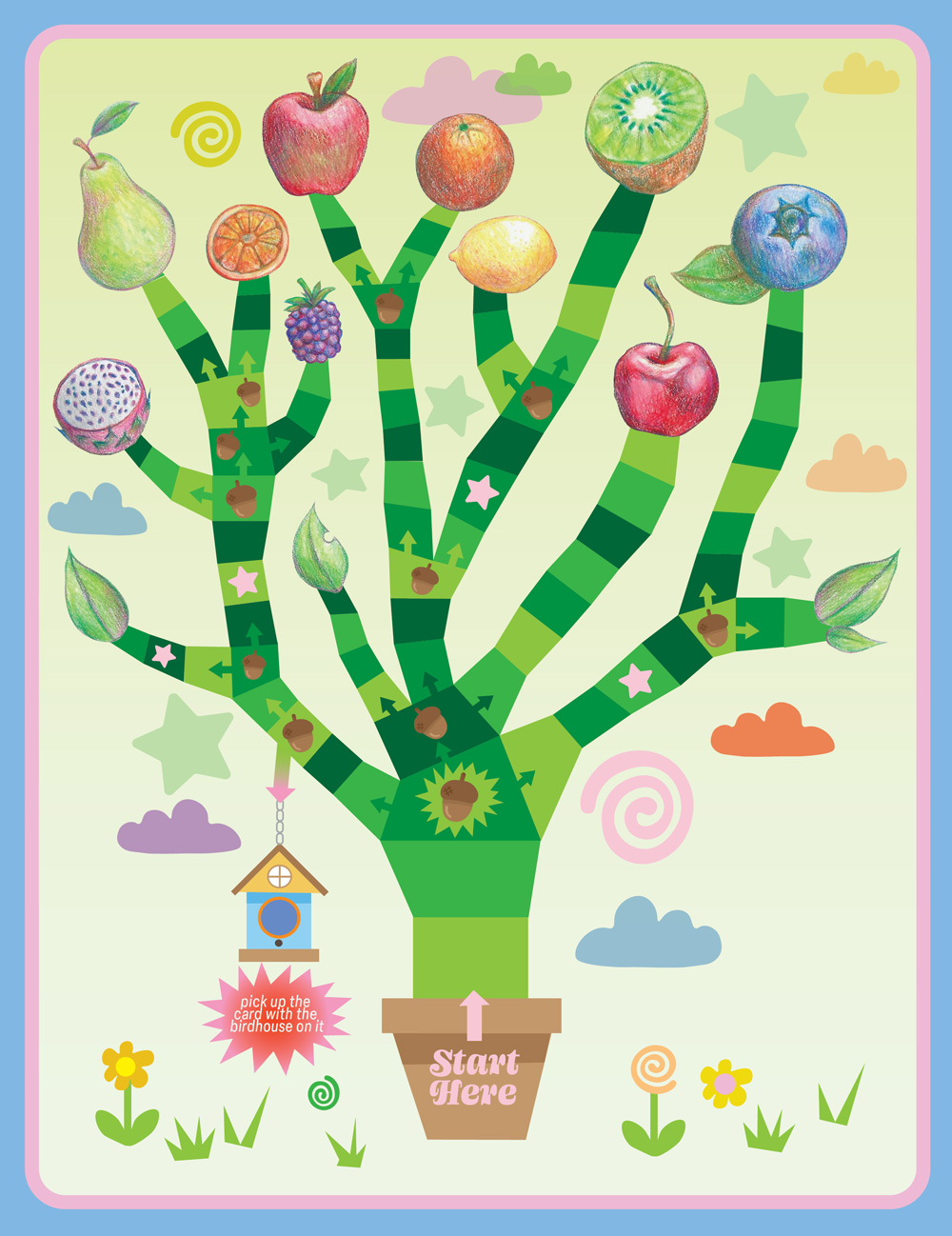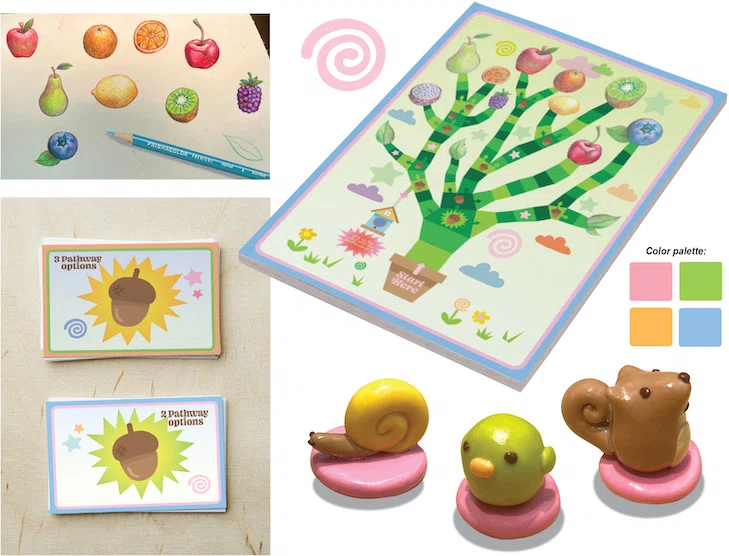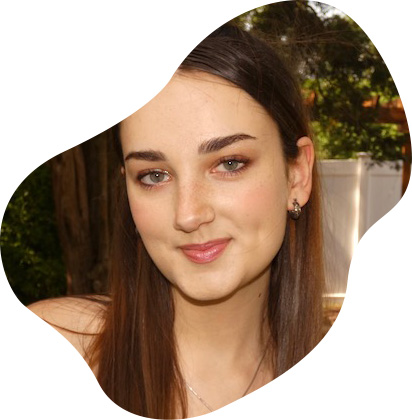

Choose-Your-Own-Adventure Board Game

Height: 13' x Width: 10" | Material(s): Colored pencil on paper, Adobe Illustrator | Process(es): Choose your own adventure board game, fruit drawn with colored pencil and scanned digitally | Citation(s): Draws inspiration from children's book The Very Hungry Caterpillar by Eric Carle | Curatorial Note: The idea of alternate realities based on your actions in the form of a game board was done in a very elegant and polished manner.
Sara Egan
Student statement
Student statement
Does your work reference or draw on a contemporary or historical art-making style, practice, or tradition? If so, please explain.
My work is inspired by contemporary board games, blending the digital illustration style commonly seen in them with my own personal twist through hand-drawn colored pencil illustrations.
Please describe the context for how the idea for this artwork originated (was this part of your sustained investigation, an independent project, a class assignment, created during a summer study, etc.).
My sustained investigation explores the idea of the butterfly effect and the domino effect and how small moments can lead to large changes. I wanted to focus on the importance of context and how everything happens because of something else. This exploration of the consequences of personal choices inspired me to design a choose-your-own-adventure board game, where players navigate a series of decisions that shape their final outcomes. By creating multiple pathways and outcomes, I looked to mirror the unpredictability of life’s small moments and the way they can alter our personal narratives. Through this design, I aimed to highlight the complexity and interconnectedness of decisions, encouraging reflection on how our actions influence both ourselves and those around us.

Material(s): Colored pencil on paper, Adobe Illustrator, polymer clay, glaze | Process(es): Sculpted board game pieces. Made cards for the game focusing on decision-making | Citation(s): Inspired by the board game Candy Land
How did you demonstrate revision in your sustained investigation?
I started with a historical approach, exploring the butterfly effect in terms of real, large-scale ideas. As my sustained investigation developed, I narrowed to a more personal approach, focusing on how the domino effect impacts individuals and small groups of people. This led to my interest in the idea of small moments leading to alternate realities, proposing the question, "What if things were different?" As I revised and developed my sustained investigation, I came to realize that the interconnected nature of life is present through such a broad array of human (and even nonhuman) interactions. The development of my sustained investigation deepened my understanding of how seemingly small actions can create a ripple effect, producing different outcomes across various perspectives—whether historical, personal, natural, or even imaginary.
Your work was selected in part because it achieved synthesis. Can you explain your intentionality in choosing materials and developing processes to further your ideas?
I decided to depict the idea of the butterfly effect through a choose-your-own-adventure board game, taking inspiration from modern board games, like The Game of Life. I thought that a tree would be an effective way of depicting this concept as it highlights the "branching-off" aspect of making decisions through the literal branches of the tree.

I focused on handling the consequences of your actions and how decisions can have an exponential effect.
How did your materials and process(es) choices shape the creation or meaning of your artwork(s)?
In my design process, I took inspiration from Eric Carle's book The Very Hungry Caterpillar. I wanted to pay homage to this book because it emphasizes the importance of one's own actions in helping themselves grow as a person. The children's book affirms that you can make good choices to control your future in a way that is understandable to a younger audience. Building off that idea, I wanted to create something that was also intended for children, a board game, whilst displaying themes of the domino effect. This book was able to inspire not only the concept of my design but also the stylistic aspect of the game. I displayed green stripes in the design of my tree to pay reference to the green-striped caterpillar from the book. I also displayed different hand-drawn fruits throughout the board game, as I admired the hand-drawn look of Eric Carle's illustrations.
What is your advice to other AP Art and Design students?
My advice to other AP Art and Design students is to create work that truly interests you. These courses offer the freedom to explore whatever inspires you and allow young artists to flourish in their own unique ways. I encourage you to take full advantage of this opportunity, dive deep into research, and focus on the subjects or themes that ignite your passion.
Norman Chow
Art Specialist
South Brunswick High School, Monmouth Junction, NJ, USA
Teacher statement
Teacher statement
The AP Art and Design course supports inquiry-based personalized learning in the sustained investigation portfolio component. What strategies helped you guide students through inquiry?
In the beginning, when the students were identifying their sustained investigation, I had them break the overall topic into 10 to 11 subtopics. If it did not meet the criteria, the students would have to figure out another sustained investigation. I emphasize the inquiry phase of their pieces. They must identify the project's objective, conduct artistic research, provide at least three compositions, and finally experiment with media. The students are encouraged to see what medium and color scheme best represents their idea.
How did you structure practice, experimentation, and revision into your AP Art and Design curriculum?
I give the students a week before transitioning to their final project to experiment with different mediums and explore different surface areas to assess what will best represent their idea. During revision, I always encourage the students to see how they can incorporate some digital components into their pieces.
How do you support your students in the Selected Works portfolio component?
I treat it like a portfolio review of their entire high school career. We will lay out all their work and systematically identify their best pieces. I encourage the students to showcase a drawing, a painting, digital (if any), and mixed-media pieces. Afterward, we arrange their pieces from strongest to weakest and anchor them with another strong piece.
What did you learn from working with your student?
What I learned from working with Sara was respecting a student's intuition and creativity. You can make suggestions here and there but never take away their creative freedom by having the student use your idea instead.
Sara Egan




